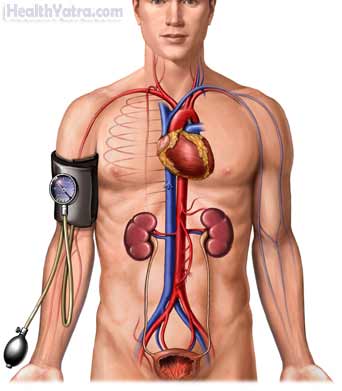Definition
Orthostatic hypotension is a condition of abnormal blood pressure regulation upon standing. The blood pressure quickly decreases, more than 20/10 mm Hg, when rising from a lying down or sitting position to a standing position.
Causes
Orthostatic hypotension has several causes.
- Hypovolemia is the most common cause. It may be due to:
- Excessive use of loop diuretic medications
- Vasodilator medications, such as nitrate preparations, Ca blockers, or ACE inhibitors
- Dehydration
- Prolonged bedrest
- Addison’s disease with inadequate salt intake
- Impaired autonomic (nerve) reflex due to certain diseases:
- Diabetes
- Pernicious anemia
- Amyloidosis
- Guillain-Barre syndrome
- Riley-Day syndrome
- Shy-Drager syndrome
- Decreased heart muscle contractility or vascular responsiveness
- Certain drugs:
- Monoamine oxidase (MAO) inhibitors
- Tricyclic antidepressants
- Tetracyclic antidepressants
- Phenothiazine antipsychotic drugs, such as chlorpromazine, promazine, thioridazine
- Atypical antipsychotics
- Quinidine
- Levodopa
- Barbiturates
- Alcohol
Risk Factors
Factors that increase your chances of getting orthostatic hypotension include:
- Increased age
- Use of certain drugs:
- Loop diuretics
- Vasodilators
- MAO inhibitors
- Tricyclic antidepressants
- Tetracyclic antidepressants
- Phenothiazine antipsychotic drugs
- Quinidine
- Levodopa
- Barbiturates
- Alcohol
- Inadequate fluid intake
- Prolonged bedrest
- Certain diseases or conditions:
- Atherosclerosis
- Advanced heart failure
- Addison’s disease
- Diabetes
- Pernicious anemia
- Amyloidosis
- Guillain-Barre syndrome
- Riley-Day syndrome
- Shy-Drager syndrome
Symptoms
Symptoms of orthostatic hypotension include:
- Mild to moderate reduction in brain blood flow:
- Faintness
- Light-headedness
- Weakness
- Confusion
- Visual blurring
- Severe reduction in brain blood flow:
- Fainting or brief loss of consciousness
Exercise or having eaten a heavy meal may worsen symptoms.
If you experience any of these symptoms do not assume it is due to orthostatic hypotension. These symptoms may be caused by other health conditions.
Diagnosis
Orthostatic hypotension is diagnosed when symptoms are present and there is a measured reduction in blood pressure while standing, which is relieved by lying down.
Treatment
Treatment for orthostatic hypotension depends on the cause.
Treatments include:
Adjusting Dosage or Type of Medication
When orthostatic hypotension is due to hypovolemia related to medications, adjusting or stopping medication may be needed to reverse the condition.
Treating Dehydration
Orthostatic hypotension resulting from dehydration is treated with fluids and electrolyte replacement.
Minimizing Bedrest
If bedrest is the cause of orthostatic hypotension, symptoms may be improved by increasing time spent sitting up in bed.
Medications
A number of medications may be given to boost blood pressure. Over-the-counter medications include caffeine and ibuprofen.
Other Interventions
In some cases, individuals may be encouraged to increase their intake of salt. Fitted elastic stockings that go up to the waist may be worn. Individuals may need to be taught to rise from lying down, to sit up, and to stand in a slow and gradual manner. Similarly, they should be discouraged from standing still for too long a time.
If you are diagnosed with orthostatic hypotension, follow your doctor’s instructions .
Prevention
There is no way to prevent orthostatic hypotension if it is a result of other diseases or conditions. However, if your orthostatic hypotension relates to medications, dehydration, or bedrest, you should talk with your healthcare provider about treatment options.

